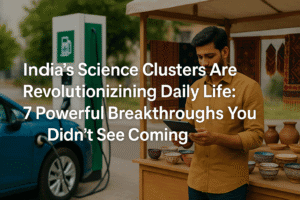India’s Science Clusters Are Revolutionizing Daily Life: 7 Powerful Breakthroughs You Didn’t See Coming
India’s eight regional Science & Technology Clusters are demonstrating tangible progress in solving everyday problems through collaborative innovation. Moving beyond theory, recent outcomes include Delhi’s EV charging infrastructure deployment, the Kalaanubhav.in AR/VR artisan marketplace, and the popular “One Delhi” transit app. Crucially, these hubs force collaboration between academia, industry, startups, and local governments to tackle region-specific challenges like healthcare (diabetic foot mats, indigenous pacemaker leads) and sustainability (e-waste, One Health). The unique model bridges the gap between research and real-world application.
A new focus on inter-cluster collaboration aims to replicate and scale successful local solutions nationally, amplifying impact. This approach signifies a shift towards demand-driven, systemic innovation that addresses India’s diverse needs while building resilient regional ecosystems beyond isolated technological fixes.

India’s Science Clusters Are Revolutionizing Daily Life: 7 Powerful Breakthroughs You Didn’t See Coming
While government reports often gather digital dust, the latest update on India’s Science and Technology (S&T) Clusters reveals something different: tangible innovations solving real problems for real people. Spearheaded by the Office of the Principal Scientific Adviser (PSA), Prof. Ajay Kumar Sood, these eight regional hubs are demonstrating that collaborative science isn’t just about papers—it’s about pavement.
Beyond Buzzwords: Innovation with Boots on the Ground
The 2024-2025 S&T Cluster report, recently released, moves beyond abstract goals to showcase concrete impacts:
- Delhi/NCR Gets an EV Charge: The Delhi Research Implementation and Innovation Cluster (DRIIV) isn’t just theorizing about electric mobility; it’s actively deploying charging infrastructure, tackling a major hurdle for EV adoption head-on.
- Crafting a Digital Future for Artisans: The launch of Kalaanubhav.in (likely originating from a cluster like Pune or Bhubaneswar) is more than a website. This AR/VR-enabled marketplace connects traditional artisans directly with global consumers, preserving heritage while creating sustainable livelihoods in the digital age.
- “One Delhi” Unlocks Urban Mobility: DRIIV’s “One Delhi” transit app, already embraced by over 300,000 users, exemplifies the clusters’ focus on practical urban solutions. It simplifies the complex choreography of navigating a megacity.
- Health Tech Saving Limbs and Lives: Innovations like diabetic foot screening foot-mats (crucial for early detection and preventing amputations) and the indigenous development of pacemaker leads at the Andhra Pradesh Medtech Zone (AMTZ Vizag) address critical, life-altering healthcare gaps.
- Holistic Systems Thinking: Initiatives in One Health (recognizing the interconnection of human, animal, and environmental health) and e-waste management highlight the clusters’ commitment to systemic, sustainable solutions beyond isolated tech fixes.
The Engine: Collaboration, Not Competition
The true power of these clusters lies in their foundational principle: forced collaboration. As Prof. Sood emphasized, the model deliberately brings together historically siloed players:
- Academic Institutions & R&D Labs: Providing cutting-edge research and talent.
- Industry: Offering market insight, scaling capabilities, and real-world problem statements.
- Startups: Injecting agility, disruptive thinking, and rapid prototyping.
- Local Governments: Ensuring solutions are grounded in local needs and regulatory realities.
This unique ecosystem tackles the classic “lab-to-market” valley of death by design. Problems aren’t solved in isolation; solutions are demand-driven and co-created.
The Next Leap: Synergy Across the Map
Perhaps the most promising development is the push for “inter-cluster collaborations.” Prof. Sood highlighted this strategic move to replicate and scale successful regional innovations nationally. Imagine:
- The artisan marketplace model pioneered in one cluster adapted for weaving communities in another.
- A health-tech solution developed at AMTZ Vizag being deployed via the Bangalore or Hyderabad clusters.
- Urban mobility lessons from “One Delhi” informing transit apps in Pune or Bhubaneswar.
This cross-pollination avoids redundant effort and leverages India’s vast diversity as a strength, allowing the best solutions to emerge and spread rapidly.
Why This Model Matters for India’s Future
The S&T Clusters represent a fundamental shift:
- Solving Local, Impacting National: They prove that solutions born from specific regional challenges (urban transit, artisan support, specialized healthcare access) can have scalable, national relevance.
- Democracy of Innovation: By connecting grassroots problems (like diabetic foot care in villages) with top-tier scientific talent and industry, they democratize the innovation process.
- Building Resilient Ecosystems: The clusters foster self-sustaining regional innovation ecosystems, reducing dependency on isolated central initiatives and creating local capacity.
- Beyond “Jugaad” to Systematic Innovation: They move the narrative from one-off frugal innovations to a structured, replicable model for sustained, high-impact technological problem-solving.
The Takeaway: Innovation Rooted in Reality
India‘s S&T Clusters are more than just another government scheme. They are living experiments proving that when scientists, entrepreneurs, industry leaders, and policymakers are physically and strategically aligned around regional needs, the results aren’t confined to reports. They manifest as charging stations powering cleaner commutes, apps simplifying complex journeys, marketplaces empowering artisans, and medical devices saving lives. The clusters are quietly building the infrastructure of India’s innovation future – one practical, impactful solution at a time. Their success hinges not just on funding, but on sustaining this unique culture of collaboration that turns shared challenges into shared triumphs.
You must be logged in to post a comment.